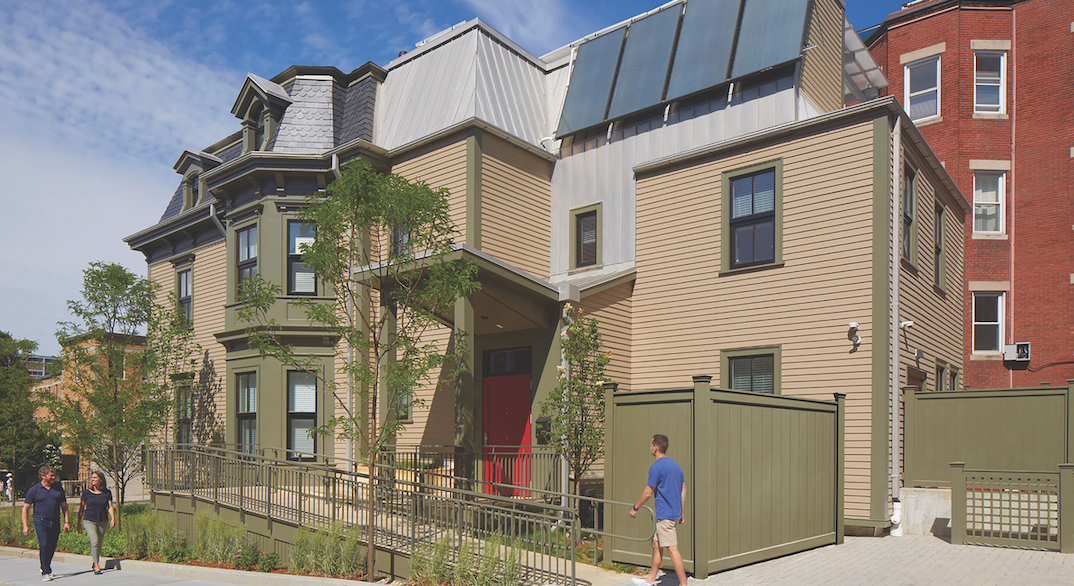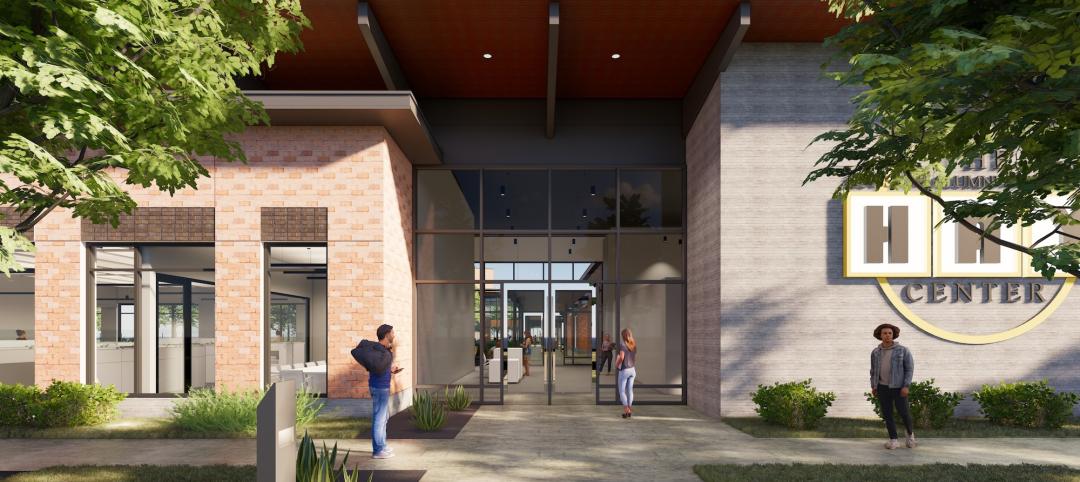Two years ago, Cambridge, Mass., adopted ambitious net-zero energy standards for the construction and renovation of city-owned properties. One of the first projects to fall under this rubric was an 1885 Victorian home at 859 Massachusetts Avenue. The 7,500-sf structure, which was being used as office space, has since been refashioned into a 10-unit shelter for homeless families.
The LEED Gold–certified structure has been operating at “near-net-zero” energy use. Because Cambridge has a strong historic preservation ethos, the project team had to carefully balance energy conservation with the preservation of historical integrity.
The facility replaced a deteriorating structure of similar age and size. “Fortunately, this house was solidly built,” said Lori Cowles, AIA, President of HMFH Architects, the design firm on the project. But its faded aluminum siding, jerry-built front entryway, rusting fire escapes, and paved-over gardens were obvious signs of decline.
The building needed extensive work to be made suitable for modern residential use. The City of Cambridge invested $5 million of city tax dollars in the renovation. “The city believed that the residents deserved a beautiful space,” said Ellen Semonoff, Assistant City Manager, Human Services.
Demolition revealed unexpected structural deficiencies. Floorboards, joists, and sections of flooring were rotted. “The flooring had some hand-hewn boards that were not standard-sized,” said Brendon Roy, Project Manager for the city. “They had to be shimmed or cut down to make them work.” New footings were poured to reinforce the structure. The rubble foundation required extensive patching.
A MAJOR SETBACK, A NEW OPPORTUNITY FOR MULTIFAMILY HOUSING
One of the keys to reaching net zero was to install a geothermal heating/cooling system. But two attempts to drill 900-foot wells on site resulted in nothing but broken drill bits. At this point construction was well under way, so the city decided to drop the geothermal option.
That turned out to be a blessing. The mechanical engineer, Garcia, Galuska & DeSousa, substituted variable refrigerant flow technology with an above-ground air-to-water cooler. “The efficiency on this system turned out to be better than a geothermal well,” said Roy.
A generously insulated, tight envelope was critical to achieving net-zero energy efficiency. The thickness of exterior walls was doubled so that a six-inch layer of continuous mineral wool outboard of the studs could be applied. Four inches of cellulose insulation was blown in between the studs. The interior of the foundation was insulated with 4½ inches of closed-cell spray foam.
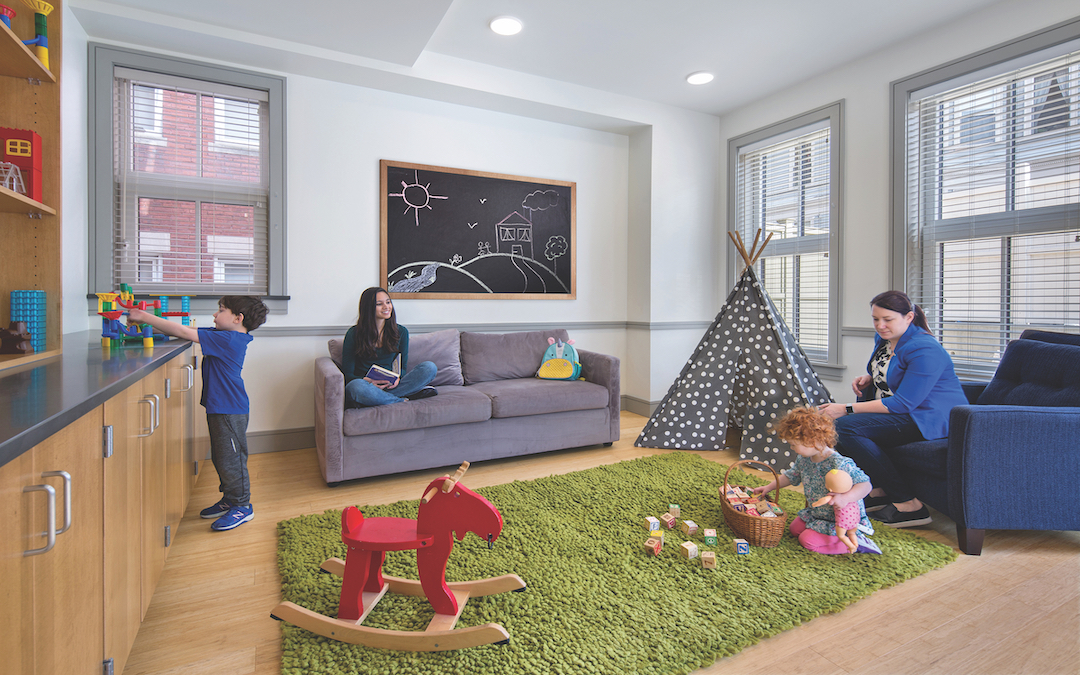 Children share a playroom at Renae’s Place. There’s also a play structure in the backyard. Horizons for Homeless Children hosts a play space weeknights to give parents time to work on job applications and résumés. YWCA Cambridge provides social services and manages the property for the city. Photo: Ed Wonsek
Children share a playroom at Renae’s Place. There’s also a play structure in the backyard. Horizons for Homeless Children hosts a play space weeknights to give parents time to work on job applications and résumés. YWCA Cambridge provides social services and manages the property for the city. Photo: Ed Wonsek
Eight inches of cellulose insulation was blown in between the roof rafters, and five inches of rigid extruded polyisocyanurate was installed under a section of flat roof.
Zola Thermo-Clad doors and windows from Germany, made with aluminum-clad wood and triple-glazed with a low-e coating, yielded an R-7 insulation value. “They are better insulated than any other doors and windows—almost three inches thick,” said Roy. “This was bleeding-edge technology, and because they were sourced from Germany, there were longer lead times. But this was something we needed to do to get to net zero, even if it will take 30 years to pay off.”
Final energy use calculations for the first year were not available at this writing. Based on available data, the structure has a predicted site energy use intensity of 17.02 kBtu/sf/year compared to 59.6 site EUI for a typical multifamily building of this type.
HISTORICAL COMMISSION PROVES FLEXIBLE FOR THIS MULTIFAMILY DEVELOPMENT
The Cambridge Historical Commission, which was involved from the early design stage, was open to accepting less than total historic accuracy in some cases. “Cambridge has a wealth of homes from different time periods,” said Cowles. “This is not a one-of-a-kind for the city.” Even though the imported tilt-turn windows were not historically accurate, the commission acknowledged that their tight-sealing capability was crucial to the success of the net-zero energy scheme.
The commission also approved cellular PVC cornices and trim that looked close enough to the original wood from a distance and would be more durable than wood. After the aluminum siding was removed, new clues were revealed. “We could see ghosts of architectural details,” said Cowles. This shadowing helped in the selection of historically accurate exterior features.
Being true to the original design required extensive detective work. “Many of the buildings on the block from that era were gone,” said Cowles. HMFH designers pored over old photographs of the property to help choose appropriate detail features. “We were lucky that the city’s historical commission keeps good records,” said Cowles.
Built during the late Victorian period, the original structure was not as ornate as those constructed in the high Victorian era, “with all the bells and whistles,” said Cowles. Research showed that bright tones were not available at that time, so a muted tan and green color scheme was chosen.
Putting solar panels on roofs is almost always prohibited in historic building projects, but the project team got lucky. “Due to the shape of the roofline, you can’t see the panels from the street, so we were able to put panels on the roof,” said Cowles. Solar thermal collectors mounted to the roof provide hot water.
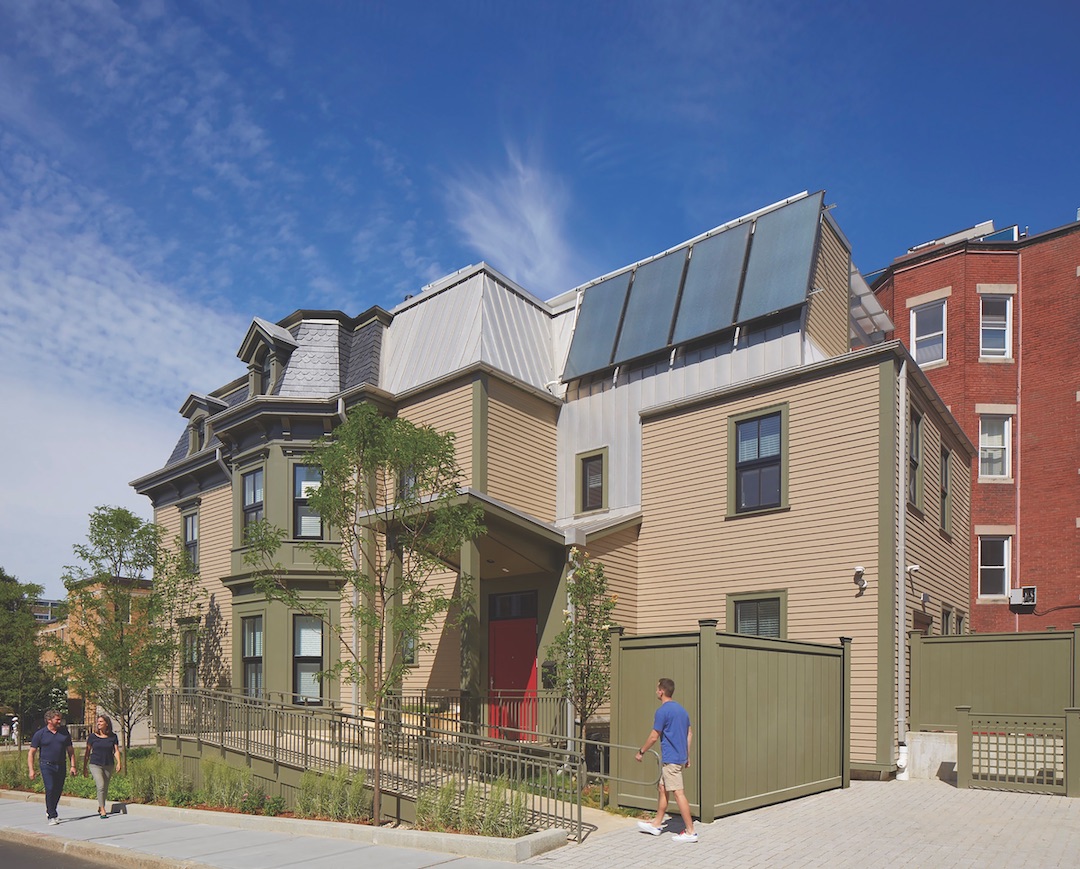 Rather than try to dress up a nonconforming late addition (at right in photo) in Victorian style, designers left it looking pretty much as is and hung photovoltaics at the roof level. PVs on the roof of the original mansion were permitted by the historical commission because they were obscured from street view. Photo: Bruce T. Martin
Rather than try to dress up a nonconforming late addition (at right in photo) in Victorian style, designers left it looking pretty much as is and hung photovoltaics at the roof level. PVs on the roof of the original mansion were permitted by the historical commission because they were obscured from street view. Photo: Bruce T. Martin
The PVs are capable of generating 15.51 KW. But because the local utility does not allow PV systems in this area to export power back to the grid, the property cannot benefit from net metering, and thus does not reap the full benefit of its solar-generating capacity.
The structure probably would have achieved its net-zero goal but for the restriction preventing net metering and the need to put a refrigerator in every unit.
The shelter opened in June 2018. Residents, primarily homeless women and their children, typically spend about 18 months in the facility while they wait for more permanent housing. The upgrades include two units for residents with disabilities.
The units range in size from 220 to 260 sf and can accommodate an adult and one or two children—a tight fit, but better than the alternative. Interiors feature solid surface Caesarstone countertops and LED lighting with sensor technology. There are group kitchens with energy-efficient induction cooktops and dining areas on each floor. Children share a playroom as well as a backyard with a play structure. A private room affords space to case managers from YWCA Cambridge, which manages the building under contract with the city, for confidential meetings with residents about social services.
Aesthetically, the historically reverential restoration is now seen as an asset to the neighborhood instead of a blight. It was named Renae’s Place, for Renae Gray, a longtime activist affiliated with the YWCA. “She died a year before it opened,” said Semonoff. “It embodies her spirit.”
PROJECT TEAM | RENAE’S PLACE
CLIENT City of Cambridge, Mass.
PROPERTY MANAGER YWCA Cambridge
ARCHITECT HMFH Architects
MECHANICAL ENGINEER Garcia, Galuska & DeSousa
GENERAL CONTRACTOR Homer Contracting
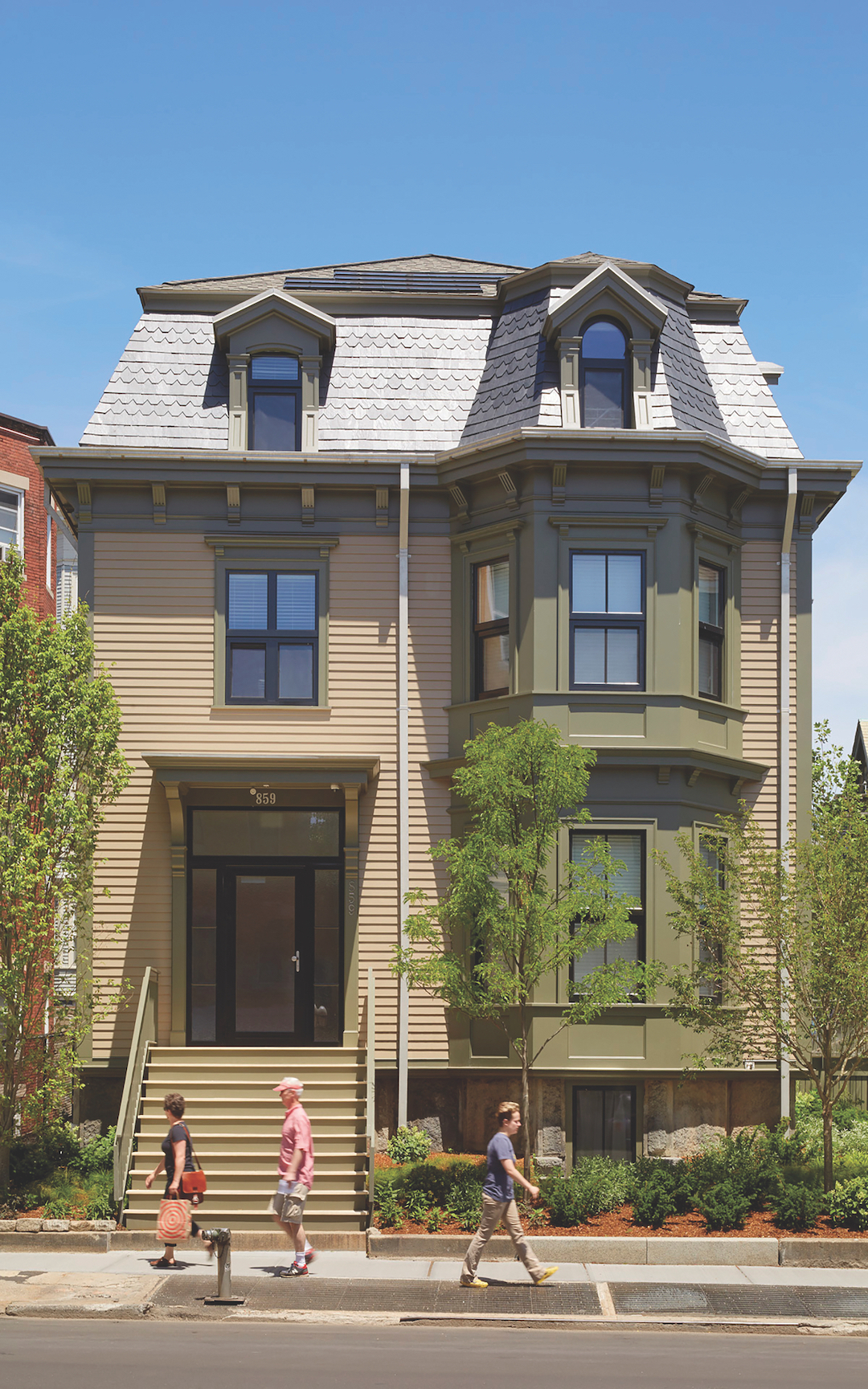 Photo: Bruce T. Martin
Photo: Bruce T. Martin
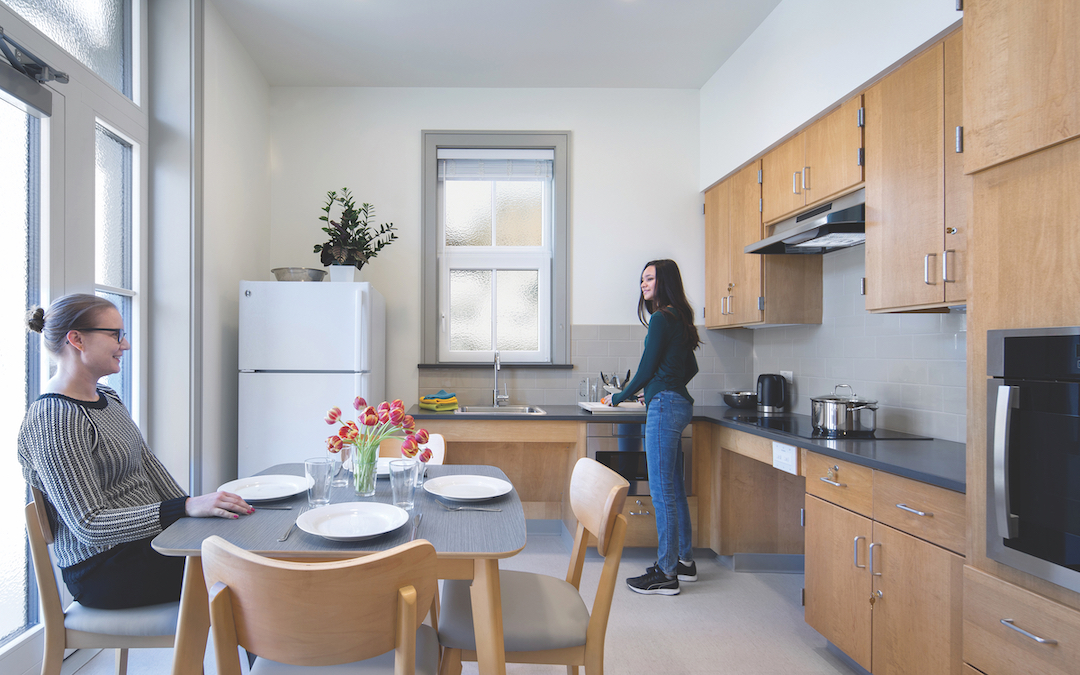 Photo: Ed Wonsek
Photo: Ed Wonsek
Related Stories
Sustainability | Aug 15, 2023
Carbon management platform offers free carbon emissions assessment for NYC buildings
nZero, developer of a real-time carbon accounting and management platform, is offering free carbon emissions assessments for buildings in New York City. The offer is intended to help building owners prepare for the city’s upcoming Local Law 97 reporting requirements and compliance. This law will soon assess monetary fines for buildings with emissions that are in non-compliance.
Sponsored | Multifamily Housing | Aug 15, 2023
Embracing Integrations: When Access Control Becomes Greater Than the Sum of Its Parts
Multifamily Housing | Aug 11, 2023
Hotels extend market reach with branded multifamily residences
The line separating hospitality and residential living keeps getting thinner. Multifamily developers are attracting renters and owners to their properties with hotel-like amenities and services. Post-COVID, more business travelers are building in extra days to their trips for leisure. Buildings that mix hotel rooms with for-sale or rental apartments are increasingly common.
MFPRO+ New Projects | Aug 10, 2023
Atlanta’s Old Fourth Ward gets a 21-story, 162-unit multifamily residential building
East of downtown Atlanta, a new residential building called Signal House will provide the city with 162 units ranging from one to three bedrooms. Located on the Atlanta BeltLine, a former railway corridor, the 21-story building is part of the latest phase of Ponce City Market, a onetime Sears building and now a mixed-use complex.
Senior Living Design | Aug 7, 2023
Putting 9 senior living market trends into perspective
Brad Perkins, FAIA, a veteran of more than four decades in the planning and design of senior living communities, looks at where the market is heading in the immediate future.
Multifamily Housing | Jul 31, 2023
6 multifamily housing projects win 2023 LEED Homes Awards
The 2023 LEED Homes Awards winners in the multifamily space represent green, LEED-certified buildings designed to provide clean indoor air and reduced energy consumption.
MFPRO+ New Projects | Jul 27, 2023
OMA, Beyer Blinder Belle design a pair of sculptural residential towers in Brooklyn
Eagle + West, composed of two sculptural residential towers with complementary shapes, have added 745 rental units to a post-industrial waterfront in Brooklyn, N.Y. Rising from a mixed-use podium on an expansive site, the towers include luxury penthouses on the top floors, numerous market rate rental units, and 30% of units designated for affordable housing.
Affordable Housing | Jul 27, 2023
Houston to soon have 50 new residential units for youth leaving foster care
Houston will soon have 50 new residential units for youth leaving the foster care system and entering adulthood. The Houston Alumni and Youth (HAY) Center has broken ground on its 59,000-sf campus, with completion expected by July 2024. The HAY Center is a nonprofit program of Harris County Resources for Children and Adults and for foster youth ages 14-25 transitioning to adulthood in the Houston community.
Adaptive Reuse | Jul 27, 2023
Number of U.S. adaptive reuse projects jumps to 122,000 from 77,000
The number of adaptive reuse projects in the pipeline grew to a record 122,000 in 2023 from 77,000 registered last year, according to RentCafe’s annual Adaptive Reuse Report. Of the 122,000 apartments currently undergoing conversion, 45,000 are the result of office repurposing, representing 37% of the total, followed by hotels (23% of future projects).
Multifamily Housing | Jul 25, 2023
San Francisco seeks proposals for adaptive reuse of underutilized downtown office buildings
The City of San Francisco released a Request For Interest to identify office building conversions that city officials could help expedite with zoning changes, regulatory measures, and financial incentives.


